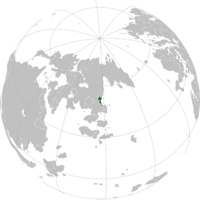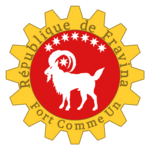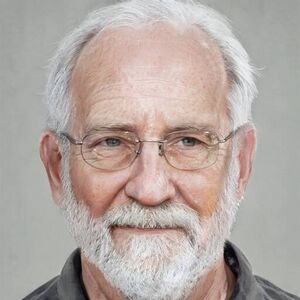Fravina
This article is incomplete because it is pending further input from participants, or it is a work-in-progress by one author. Please comment on this article's talk page to share your input, comments and questions. Note: To contribute to this article, you may need to seek help from the author(s) of this page. |
Republic of Fravina République de Fravina | |
|---|---|
Motto: Fort Comme Un Strong as One | |
 | |
| Capital and largest city | Port de Sang |
| Official languages | Lysian |
| Recognised national languages | Fravi |
| Ethnic groups (2019) | |
| Religion (2019) | |
| Demonym(s) | Frav (singular)
Fravs (plural) Fravi (adjective) |
| Government | semi-direct democratic federal republic |
| Bernard Beaumont | |
| Adelie Grasse Valentine LaClaire Louise Rochefort | |
| Legislature | People's Council |
| Wing of Examination | |
| Wing of Legislation | |
| Establishment | |
• Treaty of Labrador | 8 December 1809 |
• First Constitution of Fravina | 24 April 1810 |
• Second Constitution of Fravina | 16 June 1949 |
• Third Constitution of Fravina | 3 September 1960 |
| Area | |
• Total | 48,156 sq mi (124,720 km2) |
| Population | |
• 2019 census | 37,654,800 |
• Density | 485.87/km2 (1,258.4/sq mi) |
| GDP (nominal) | 2019 estimate |
• Total | 434,829,346,344 |
• Per capita | 11,547.78 |
| Currency | aure (Ā) (AFV) |
| Time zone | UTC+0 (UTC) |
| Date format | dd-mm-yyyy |
| Driving side | right |
| Calling code | +48 |
| Internet TLD | .fv |
Fravina (Lysian: Fravina), officially the Republic of Fravina (Lysian: République de Fravina) is a nation located on Argis on Eurth, bordered by Velaheria to the southwest, Delamaria to the southeast, and the Adlantic Ocean to the east. Made up of 37.6 million Fravs, it comprises of both colonial and native people groups, primarily from Lysian heritage, with various areas of indigenous majorities. Colonies first were founded in the late 1400s to 1500s, by Europan powers, which often came into conflict with the indigenous Frav Empire.
Fravina is a semi-direct democratic federal republic, with three separate branches of government and a bicameral legislature, called the People's Council of Fravina. The nation's executive branch is headed by the president and four vice presidents, known as the Vice Presidential Council. The socialists have maintained power in Fravina since 1948, with other parties forming a token opposition. Fravina's capital and largest city is Port de Sang.
Etymology
Originally applied to a smaller portion of the current territory, the name Fravina comes from an endonym meaning "people of the river". The earliest linguistic evidence points to tribal origins of the name Fravina. It is derived by combining the indigenous Frav people and the Frav word ina meaning river. The actual river of this name refers to the Orléans River.
History
Indigenous peoples and pre-colonial era
The earliest known complex civilization in Fravina was the Iritina, who lived in the southern regions of modern-day Fravina. While much of Iritina history is lost, historians know that the Iritina civilization flourished around 800 BC with a culture and language distinct from surrounding civilizations. By 869 BC, the city of Dikasa conquered other Iritina cities and formed the Iritina Empire.
By approximately 780 BC, Iritina collapsed from unknown reasons. Historians speculate that it may have fell from the migrating Alonisin tribes from the west, civil war, natural disasters, or any combination of the three. After that, Fravina was mainly composed of three groups - the Iritina, Alonisin, and Diadi. The three were constantly in conflict with each other and with themselves over resources. Around 270 AD, some of the Idaha tribes from the south, in modern-day Delamaria, migrated to Fravina. The Idaha and Iritina were constantly at war, which led to the extinction of the Iritina people around 800 AD.
Around 1400, four Fravi cities along the Orléans River formed an alliance. This alliance, called the Frav Empire, was headed by the city of Tesina, modern-day Port de Sang. By the way of several conquests, the Frav Empire grew to encompass the Alonisin and Diadi people by around 1500.
Lysian colonization
When Fravina was first discovered by Europan explorers it was named Lysian Columbia by the Lysian explorer Louis Boneparte.
Early colonizers were often in conflict with the Frav Empire, but by 1695, the Frav Empire fell to Lysian forces led by Admiral Louis Orléans. Colonizers occupied the Four Cities, renaming them Port de Orléans, Belleville, Beaufort, and Cour de Valentine. The three colonies of Fravina (Prétredy, Orléans and d'Olivier) were used as penal colonies by Lysia.
Many settlers were inticed by a number of economic speculative bubbles such as the fur trade, exotic plant trade as well as the construction boom in the late 18th century. Major exports of early colonies were flowers, fur, vegetables native to the new world as well as tobacco.
Lysian Columbia
The three colonies of Fravina declared independence from Lysia in 1778, and became a part of Lysian Columbia. As part of the nation, Fravina participated in the Delamarian War of 1804 against Labradoria. The war resulted in a Columbian loss. In the Treaty of Labrador (1809), Fravina was made independent from Lysian Columbia.
First Republic
The First Republic of Fravina had collected a large debt during the Delamarian War that it struggled to pay off. The debt continued to increase during the Fravina Shipping Crisis of 1833, the Native Fravi Rebellions, and the Fravina Labour Strikes of the 1880s. By the late 1800s, Fravina suffered from corruption.
Civil Wars
The First Civil War of Fravina (1896-1902) between the Indigenous Confederacy, Fravi Socialists, and the First Republic of Fravina. Beginning with the Proclamation of Indigenous Independence in October 1896, the war grew to include the Socialists when President Pierre Antier began persecuting the group in an attempt to stop the Socialists from expressing support for the Indigenous Confederacy. Despite initial losses, the Republic won the war in 1902.
In the post-war period, Fravina struggled to rebuild, facing an economic depression. Lewis M. Nichols, a popular colonel who served in the Civil War, gained control of the Fravi government in the 1907 Fravi coup d'etat. Popular in the north, he moved the nation's capital from the southern Port de Orléans to the Fort d'Olivier on Fravina's northern border. Following Nichols's death in 1938, southern Lieutenant Colonel Jacque De Mercy and northern Brigadier General Joseph Peretti came into conflict over succession, leading to the Second Civil War of Fravina. Those for De Mercy were colloquially referred to as the Roses, and were mainly composed of socialists and so-called Green Liberals. Those for Peretti were colloquially referred to as the Irises, and were mainly composed of fascists and so-called Blue Liberals.
The mainly industrial core of the southern regions vastly contributed to their victory of 1948. The war ended in late August 1948 when the Roses, led by now Grand General De Mercy, won the Siege of Fort d'Olivier, leading to the death of Joseph Perreti.
Contemporary Fravina
The Second Republic of Fravina was formed on 15 October 1948, with Grand General Jacque De Mercy ruling as the first president. De Mercy, much like his predecessor, ruled through force and through fear. Ruling until 1956, he was deposed by Grand Admiral Nicolas Martin of the Navy and Grand General Valentin LaClaire of the Air Force. Despite being deposed, now-president Martin granted him the position of Secretary of Northern Patriotism). The deposal of De Mercy was controversial, leading to the collapse of the People's Party of Fravina into the Socialist Party of Fravina and the Social Labour Party of Fravina.
In the late 1980s and 1990s saw an increase in the standard of living in Fravina. Poverty, corruption, and decline were all on a decline during these decades. This success was largely accredited to the reforms of Presidents Marie Boche and Pierre Blanchet.
Geography
Fravina is mostly hilly and mountainous in some parts.
Port de Sang is the capital and largest city. Other major cities are Fort d'Olivier, Port de Barbier, Belleville, and Beaufort.
Politics and Government
Fravina is a semi-direct democratic federal republic with three separate branches of government and a bicameral legislature, called the People's Council of Fravina. The nation's executive branch is headed by the president and four vice presidents, known as the Vice Presidential Council. Fravina's judicial branch is made up of a series of courts, with the Grand Court acting as the highest court of appeals in Fravina.
Political Divisions
Fravina is composed of 7 provinces. Every province is entitled to its own government, headed by a governor and legislature. Every province is also entitled to 21 examiners, with an additional examiner for the four most populous provinces. The largest province by land area is Olivier, and the smallest is Orléans.
| Flag | Name | Capital | Governor | Population |
|---|---|---|---|---|
 |
Barbier | Port de Barbier | Camille Bellerose | 8,291,100 |
 |
Olivier | Fort d'Olivier | Emmanuel Olivier | 1,395,100 |
 |
Mechis | Domesis | Jean-Luc Philippe | 1,941,100 |
 |
Mont de Mercy | Mercycourt | Paula Castaner | 4,150,200 |
 |
Orléans | Beaufort | André LaGarde | 12,742,050 |
 |
Prétredy | Nouveau-Séminaire | Jean Pearson | 4,862,000 |
 |
Romarin | Naufrage | Helene Capitaine | 4,273,250 |
Political Parties and Elections
The government of Fravina officially recognizes five national political parties. This includes the Socialist Party, the Social Labour Party, the Green Party , the Blue Party, and the National People's Party. Legislative elections are held every 5 years on the first weekend of December, and examination elections are held every 5 years on the first weekend of December, with only half the seats up for election. These elections determine the seats of the People's Council, of which the majority coalition of the Wing of Legislation forms the government. The only time Fravina failed to form a government was following the 2010 election, which led Fravina to be without an executive until after the 2015 election.
In Fravina, there are two major political coalitions. The Worker's Coalition is a leftist coalition composed of the Socialist Party and the Social Labour Party. The Liberal Coalition is a centrist coalition of the Green Party and the Blue Party. The National People's Party is the only recognized national party that is not part of any major coalition.
Social Labour Bernard Beaumont, elected in 2015, is serving as President of Fravina. The three vice presidents are Adelie Grasse, Louise Rochefort, and socialist Valentine LaClaire. Leadership of the Wing of Examination is Chief Examiner Antoine Cartier. Leadership of the Wing of Legislation is the Speaker of the Legislation Ella Lambert.
In the 16th People's Council of Fravina, the Wing of Legislation is controlled by the Worker's Coalition. The Wing of Examination has been without a majority since 1 January 2011, with a plurality controlled by the Worker's Coalition.
Military
The Fravi Armed Forces (Forces Armées Fravi) are the military and paramilitary forces of Fravina, under the President of Fravina as supreme commanders. They consist of the Fravi Army (Armée de Terre Fravi), the Fravi Navy (Marine Fravi), the Fravi Air Force (Armée de l'air de Fravi), and the Fravi Civilian Army (Armée Civile Fravi), which acts as an emergency police force when needed.
Foreign Relations
Economy
Energy
Industry
Infrastructure
Transport
Demographics
Ethnic Groups
Education
As of 2017, Fravina has a simple literacy rate of 98.8% and a functional literacy rate of 93.3%


